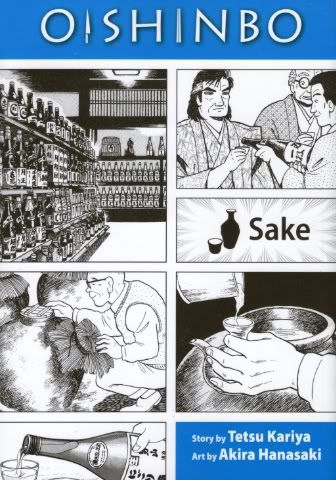 Title: Oishinbo: Sake*
Title: Oishinbo: Sake*Author: Tetsu Kariya (story) and Akira Hanasaki (art)
Publisher: VIZ Media
Rated/My Recommended Rating: T for Teen (+13)/+20 (I'LL EXPLAIN BELOW)
Synopsis: "...[A] fascinating, addictive journey through the world of cooking and food culture," as the book's back says, Oishinbo follows Shirō Yamaoka of the Tōzai News Company as he works to put together a project called the “Ultimate Menu.” As he and his coworkers progress, they deal with trial after trial, be it through trouble caused by a rival news company, or through the difficulty of finding the perfect appetizer. In the Sake volume, Yamaoka and others discover, among other things, just how unique and amazing sake is, and how it works well with a number of foods.
Review: As this was the first Oishinbo book I read, it was a great way to start out the series. Granted, the chapters are not presented in the consecutively published order (as each book contains stories relating to a specific topic), so you may have a skip in the plot (for example, two characters could be dating, and then in the next chapter, they’re married, as that chapter’s in a different book), but the book does a fairly decent job of filling in the blanks when you have a skip like that. This book is very educational, and as someone only recently ushered into the world of alcoholic beverages, it told me a lot about sake, and a little about wine and champagne as well. Additionally, there are translator’s notes in the back of the book to clarify just about any topic that readers may be unfamiliar with. I would recommend this for those (obviously) near or over 21, but the content itself isn’t so bad that a teenager wouldn’t be able to handle it. I’d only recommend it for older people because the book portrays alcoholic beverages in a positive light, and while that’s not bad per se, I endorse responsible drinking according to state and local laws…responsible parental discretion is also endorsed (as drinking ages vary or could even be non-existent depending on where you live).
Positive Messages: One could argue that this interest in finding amazing food and beverages could implicitly be extolling all the wonderful things that God has given us to eat and drink. Since Jesus Himself drank wine at parties, it’s safe to say that we can enjoy alcoholic beverages as well, provided we’re responsible with them and follow local laws and whatnot. Additionally, while Yamaoka tends to seem abrasive at first, he really has people’s best interests at heart, and wants to help them when he’s one of the few people, if not the only one, who can see both the problem and its solution clearly in a given situation. One man learns that perseverance is important, and should be applied to not only one aspect of one’s life.
Spiritual Content: There is talk of “respecting” food and drink. One character relates the “spirit” of a country to the “spirits”, or liquor, it produces. Dom Pérignon, the monk believed to have invented the method for making champagne, is mentioned.
Violence: There’s not much violence as the series focuses on food, but what is there is for the most part slapstick in nature, usually in retaliation for someone saying or doing something insulting or smart-alecky.
Language: “D---” and the misspelling “d-mm-t” appear once each. Milder language includes “heck,” “bull,” and “for Pete’s sake.” One character tells another to “stop screwing around” (in this case meaning “stop joking around”). There’s also name-calling, and insults are slung about as well.
Sexual Content: Yamaoka, in jest, says that people are only interested in women when the women are still young. In a written section, the author says that one man, made generous by drinking, offered him his wife as a gift.
Nudity: In a photorealistic panel, a shirtless man is seen from the back, making sake.
Drugs/Alcohol: Well, this volume, while in the culinary realm, focuses on a bevy of alcoholic beverages, be it the book’s namesake, sake (called Nihonshu, or “Japan’s drink”, in Japan… as we find out in the book), wine, or even champagne. That was sort of a “duh” statement. Anyways, some characters are seen drunk (one in particular is an alcoholic and another is practically in a state of constant drunkenness), but it’s not really portrayed in a positive light. In one case, heavy drinking was implied, but in a humorous manner. Also, hangovers are mentioned.
Other Negative Content: A few scenes involve sake-tasting, and, while it’s necessary in any type of alcohol-tasting event to avoid getting drunk, I personally feel that spitting out the sake was wasteful. Not a major complaint, and it could just be me who thinks this way, but I thought it was worth a mention. The waste generated by higher-quality sake is brought up. Corporate corruption is also discussed.
Yamaoka, while he’s a good and intelligent person, is quite brash and can get rather rude and defiant at times, particularly when it comes to his father.
One character expresses the desire to go to a sake brewery and taste all of its sake varieties, even though, as one character points out, she’s apparently pregnant.
No comments:
Post a Comment